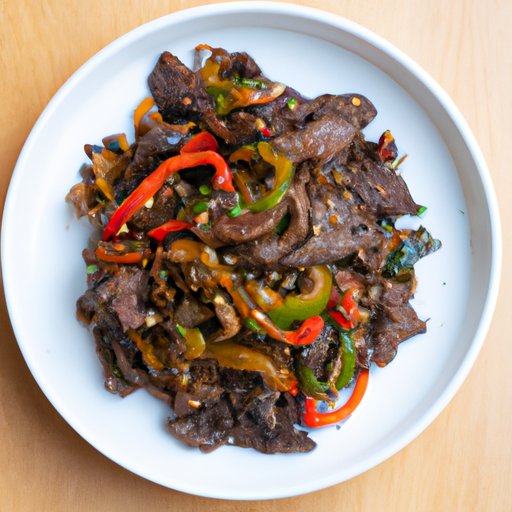Introduction
Mongolian beef has become a popular dish in many Western countries, with its savory flavor, tender beef, and unique blend of ingredients. In this article, we will explore the history, ingredients, recipe, and health benefits of this delicious stir-fry dish.
What is Mongolian Beef?
Mongolian beef is an American-Chinese stir-fry dish consisting of thinly sliced beef, vegetables, and a sweet and savory sauce. Despite its name, it does not actually originate from Mongolia, but rather was created in Taiwan and then popularized in the United States.
The dish typically features a combination of sliced beef, onions, and garlic, stir-fried in a sauce made from soy sauce, brown sugar, and hoisin sauce. It is often topped with sesame seeds or green onions for added flavor.
What Makes Mongolian Beef So Special?
Mongolian beef is known for its unique combination of ingredients, which give it its distinctive sweet, savory, and slightly spicy flavor. The sauce’s blend of soy sauce, brown sugar, hoisin sauce, and chili flakes creates a perfect balance of flavors that complements the tender beef and crisp vegetables.
Additionally, Mongolian beef sets itself apart from other stir-fry dishes with its texture. The beef is often coated in cornstarch prior to cooking, which creates a crispy exterior and a tender, juicy interior.
The History of Mongolian Beef
The origin of Mongolian beef is somewhat unclear, given that it doesn’t actually come from Mongolia. However, some sources suggest that it was inspired by Mongolian-style barbecue, which is a popular type of food in Taiwan. Others believe that the dish was created in Chinese-American restaurants in the United States as a variation on beef with broccoli.
Regardless of its origins, Mongolian beef quickly became a favorite in Chinese-American restaurants and in households across the United States.
The Recipe for Mongolian Beef
For those interested in trying Mongolian beef at home, it’s a surprisingly simple dish to make. Here’s an easy recipe to follow:
Ingredients:
- 1 pound flank steak, thinly sliced
- 1/4 cup cornstarch
- 3 tablespoons vegetable oil, divided
- 2 teaspoons minced garlic
- 1/4 cup soy sauce
- 1/4 cup brown sugar
- 1/4 cup hoisin sauce
- 1 tablespoon cornstarch
- 1/4 teaspoon red pepper flakes
- Sesame seeds and green onions for garnish
Instructions:
- Place the sliced beef in a bowl and toss with 1/4 cup cornstarch until fully coated.
- Heat 2 tablespoons of vegetable oil in a large skillet or wok over high heat. Add the beef and stir-fry until browned and crispy, then remove from skillet and set aside.
- Reduce heat to medium-high and add 1 tablespoon of vegetable oil to the skillet. Add garlic and stir-fry for 30 seconds.
- In a small bowl, mix together soy sauce, brown sugar, hoisin sauce, 1 tablespoon cornstarch, and red pepper flakes until fully combined.
- Pour the sauce into the skillet and bring to a boil. Reduce heat to medium and simmer until thickened, about 2-3 minutes.
- Add the cooked beef back into the skillet and stir until fully coated in the sauce.
- Garnish with sesame seeds and green onions, if desired.
Expert Tips and Tricks for Making Perfect Mongolian Beef
While the recipe for Mongolian beef is fairly straightforward, there are a few tips and tricks that can help ensure that it turns out perfectly:
- Be sure to slice the beef against the grain for maximum tenderness.
- Coat the beef in cornstarch prior to cooking to achieve a crispy texture.
- Heat your skillet or wok until it’s very hot before adding the beef to ensure a good sear.
- Prepare the sauce ahead of time and have it ready to add to the skillet as soon as the beef is done cooking.
- Experiment with different vegetables to find your favorite combination.
The Health Benefits of Mongolian Beef
While Mongolian beef is certainly not the healthiest dish out there, it can be made healthier with a few tweaks. For example, using leaner cuts of beef or substituting with tofu can reduce the fat content. Additionally, using a low-sodium soy sauce and reducing the amount of sugar in the recipe can make it more heart-healthy.
Regardless, Mongolian beef does offer some nutritional value. Beef is a good source of protein, iron, and other essential nutrients, while the vegetables in the dish provide vitamins and fiber.
The Future of Mongolian Beef
Mongolian beef shows no signs of losing popularity any time soon. In fact, it has become a staple in many Chinese-American restaurants and is frequently included in meal kit delivery services. As the world becomes more enamored with Asian cuisine, it’s likely that Mongolian beef will continue to be adapted and reinvented into new and exciting dishes.
Conclusion
Mongolian beef may have an origin that’s somewhat unclear, but one thing is certain: it’s a delicious and unique stir-fry dish that’s well worth trying at home. Its blend of sweet and savory flavors, tender beef, and crispy texture make it a favorite of many. With some simple tips and tricks, it’s also a surprisingly easy dish to make. Whether you’re a fan of Chinese-American cuisine or just looking for something new to try, Mongolian beef is a great choice.
